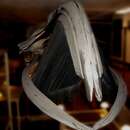Diagnostic Description
provided by FAO species catalogs
The northern right whale is one of the stockiest of all whales. It has a massive head that can be up to nearly one-third of its body length. The jawline is arched and the upper jaw is very narrow in dorsal view. The flippers are broad and tend to be more fan-shaped than the pointed flippers of most other cetaceans, There is no dorsal fin or dorsal ridge on the broad back. The flukes are very wide and smoothly tapered, with a smooth trailing edge and a deep notch. Most right whales are predominantly black, but there may be large white splotches of varying extent on the belly and chin. The head is covered with callosities, areas of roughened skin to which whale lice and sometimes barnacles attach. The largest of these callosities, on the top of the rostrum, is called the bonnet. The widely separated blowholes produce a V shaped blow up to 5 m high. Inside the mouth are 200 to 270 long thin baleen plates. which mav reach nearly 3 m in length. They are brownish grey to black in colour. The fringes of these plates are very fine, reflecting the small prey taken by this species. Can be confused with: In the northern extremes of their range, especially in the Bering and Okhotsk seas, northern right whales may be confused with bowhead whales. Bowhead whales lack callosities and right whales have white patches only on the belly.
- bibliographic citation
- Marine mammals of the world. Jefferson, T.A., S. Leatherwood & M.A. Webber - 1993. FAO species identification guide. Rome, FAO. 320 p. 587 figs. .
- author
- Food and Agriculture Organization of the UN
Size
provided by FAO species catalogs
Adults range in length to 17 m, but may occasionally reach 18 m. Females are larger than males. Newborns are 4.5 to 6 m long. Adults may reach weights of 80 to 100 t.
- bibliographic citation
- Marine mammals of the world. Jefferson, T.A., S. Leatherwood & M.A. Webber - 1993. FAO species identification guide. Rome, FAO. 320 p. 587 figs. .
- author
- Food and Agriculture Organization of the UN
Brief Summary
provided by FAO species catalogs
Right whales are mostly seen in groups of less than 12 (most often singles or pairs). Larger groups may form on feeding or breeding grounds. They can be aerially active and generally raise their flukes before a deep dive. The mating system appears to involve sperm competition (males competing to inseminate females, not so much by physical aggression, as by delivering large loads of sperm, thereby displacing that of other males). Young are born in winter and spring in tropical or subtropical breeding areas. Right whales feed on copepods and other small invertebrates, generally by slowly skimming through patches of concentrated prey at or near the surface.
- bibliographic citation
- Marine mammals of the world. Jefferson, T.A., S. Leatherwood & M.A. Webber - 1993. FAO species identification guide. Rome, FAO. 320 p. 587 figs. .
- author
- Food and Agriculture Organization of the UN
Benefits
provided by FAO species catalogs
Conservation Status : The right whales were the first targets of commercial whaling, starting in the eleventh century. They were sought after because of their thick blubber layer (and thus high yield of oil), long flexible baleen (used for many of the same purposes as plastic is today), slow swimming speeds, and tendency to float when killed. North Pacific right whales were depleted to near extinction by commercial whaling, the most recent episodes of which occurred as "scientific whaling" about 20 years ago. Sightings today are rare, apparently the species is not recovering, even under full protection. IUCN: Endagered.
- bibliographic citation
- Marine mammals of the world. Jefferson, T.A., S. Leatherwood & M.A. Webber - 1993. FAO species identification guide. Rome, FAO. 320 p. 587 figs. .
- author
- Food and Agriculture Organization of the UN

